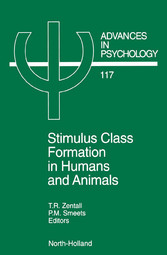Search and Find
Service
Front Cover
1
Stimulus Class Formation in Humans and Animals
4
Copyright Page
5
Contents
10
Preface
6
Part I: Introduction
12
Chapter 1. On the Origins of Behavior Structure
14
Part II: Functional and Equivalence Classes in Animals
24
Chapter 2. An Analysis of Stimulus Class Formation in Animals
26
Chapter 3. Stimulus Generalization and Hierarchical Structure in Categorization by Animals
46
Chapter 4. Acquired Equivalences and Mediated Generalization in Pigeon's Matching-to-Sample
66
Chapter 5. Categorical Class Formation by an African Grey Parrot (Psittacus erithacus)
82
Part III: Functional and Equivalence Classes in Humans
102
Chapter 6. Derived Stimulus Control: Are there Differences among Procedures and Processes
104
Chapter 7. Mediating Associations, Essentialism, and Nonsimilarity-Based Categorization
122
Part IV: Equivalence Classes: Stimulus Control Variables
146
Chapter 8. Stimulus Classes and the Untrained Acquisition of Stimulus Functions
148
Chapter 9. New Procedures for Establishing Emergent Matching Performances in Children and Adults: Implications for Stimulus Equivalence
164
Chapter 10. Stimulus Equivalence: A Class of Correlations or a Correlation of Classes
184
Chapter 11. Implications of a Stimulus Control Topography Analysis for Emergent Behavior and Stimulus Classes
208
Part V: Equivalence Classes: Verbal Behavior
230
Chapter 12. Naming and the Formation of Stimulus Classes
232
Chapter 13. Controlling Factors in Conditional Discriminations and Tests of Equivalence
264
Chapter 14. Stimulus Classes and Stimulus Relations: Arbitrary Applicable Relational Responding as an Operant
290
Author Index
312
Subject Index
320
All prices incl. VAT











